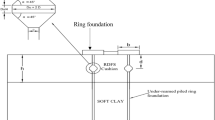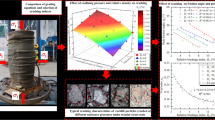Abstract
In this study, the bearing capacity and permeability of andesite and andesitic breccia rock masses, forming the basement for Gumustas waste dam, planned as a rock fill housing, were evaluated using various empirical equations and numerical analysis. The total stress constituting over the basement caused through ore waste building up in the body of dam and reservoir was determined by a finite element method. Then, this stress was compared with bearing capacities calculated for the rock masses. The permeability of rock masses in dam site and the lake were appraised with pressure water test experiments (Lugeon method), performed within opened bore holes and finite element method (seepage analysis). Since chemicals seeping from waste dams into the ground water are of vital importance for human health and the environment, the dam body must be made completely impervious using upstream slope and reservoir geosynthetics.









Similar content being viewed by others
References
Aalianvari A, Tehrani MM, Soltanimohammadi S (2013) Application of geostatistical methods to estimation of water flow from upper reservoir of Azad pumped storage power plant. Arab J Geosci 6(7):2571–2579
Alemdag S, Gurocak Z, Solanki P, Zaman M (2008) Estimation of bearing capacity of basalts at Atasu Dam site, Turkey. Bull Eng Geol Env 67:79–85
Alemdag S, Akgun A, Kaya A, Gokceoglu C (2013) A large and rapid planar failure: causes, mechanism and consequences (Mordut, Gumushane, Turkey). Arab J Geosci. doi:10.1007/s12517-012-0821-1
AlHomadhi ES (2013) New correlations of permeability and porosity versus confining pressure, cementation, and grain size and new quantitatively correlation relates permeability to porosity. Arab J Geosci. doi:10.1007/s12517-013-0928-z
Arkoc O (2013) Municipal solid waste landfill site selection using geographical information systems: a case study from Çorlu, Turkey. Arab J Geosci. doi:10.1007/s12517-013-1107-y
Arslan M, Aliyazıcıoğlu I (2001) Geochemical and petrological characteristics of the Kale (Gumushane) volcanic rocks: implications for the Eocene evolution of eastern Pontide arc volcanism, northeast Turkey. Int Geol Rev 43:595–610
ASTM (2005) Laboratory Determination of Pulse Velocities and Ultrasonic Elastic Constants of Rock. ASTM, West Conshohocken, 7 p
ASTM D 422-63 (2003) Standard test method for particle-size analysis of soils, In: Annual Book of ASTM Standards, Volume 04.08. ASTM, West Conshohocken, pp 10–17
ASTM D 4318-00 (2003) Standard test method for liquid limit, plastic limit and plasticity index of soils, In: Annual Book of ASTM Standards, Volume 04.08. ASTM, West Conshohocken, pp 582–595
ASTM D-5856 (2007) Standard test method for measurement of hydraulic conductivity of porous material using a rigid-wall, compaction-mold permeameter. Annual Book of ASTM Standards. American Society of Testing Materials, Easton
Barton NR (2008) Shear strength of rock fill, interfaces and rock joints, and their points of contact in rock dump design. Aust Centre for Geomech ISBN 978-0-9804185-3-8
Barton NR, Lien R, Lunde J (1974) Engineering classification of rock masses for the design of tunnel support. Rock Mech 4:189–239
Bieniawski ZT (1989) Engineering rock mass classifications. Wiley, New York, p 251
Celik MH, Orhan M, Ongun Y (2005) Evaluation of soil index and parameters of Balgat and Etimesgut District clay. J Polytech 8(1):87–94, Article in Turkish with an abstract in English
Ceryan N, Kesimal A, Aydın A (2009) The engineering properties of clays in Trabzon Taşonu Quarry. Pamukkale Univ J Eng Sci 15(3):447–456, Article in Turkish with an abstract in English
Coli N, Pranzini G, Alfi A, Boerio V (2008) Evaluation of rock-mass permeability tensor and prediction of tunnel inflows by means of geostructural surveys and finite element seepage analysis. Eng Geol 10:174–184
Dokuz A (2011) A slab detachment and delamination model for the generation of Carboniferous high potassium I-type magmatism in the Eastern Pontides, NE Turkey: The Köse composite pluton. Gondwana Res 19:926–944
Dokuz A, Uysal I, Kaliwoda M, Karsli O, Ottley CJ, Kandemir R (2011) Early abyssal and late SSZ-type vestiges of the Rheic oceanic mantle in the Variscan basement of the Sakarya Zone, NE Turkey: implications for the sense of subduction and opening of the Paleotethys. Lithos 127(1):176–191
Ersoy H, Bulut F, Ersoy AF, Berkün M (2008) Municipal solid waste management and practices in coastal cities of the Eastern Black Sea: a case study of Trabzon City, NE Turkey. Bull Eng Geol Env 67(3):321–333
Foyo A, Sanchez MA, Tomillo C (2005) A proposal for a secondary permeability index obtained from water pressure tests in dam foundations. Eng Geol 77:69–82
Gokceoglu C, Aksoy H (2000) New approaches for the characterization of clay-bearing, densely jointed and weak rock masses. Eng Geol 58(1):1–23
Gokceoglu C, Ulusay R, Sonmez H (2000) Factors affecting durability of the weak and clay-bearing rocks selected from Turkey with particular emphasis on the influence of the number of drying and wetting of cycles. Eng Geol 57(3–4):215–237
Gurocak Z, Alemdag S (2012) Assessment of permeability and injection depth at the Atasu dam site (Turkey) based on experimental and numerical analyses. Bull Eng Geol Env 71:221–229
Hoek E, Bray JW (1981) Rock slope engineering, institute of mining and metallurgy, 3rd edn. Austin, London
Hoek E, Carranza-Torres CT, Corkum B (2002) Hoek–Brown failure criterion-2002 edition. In: Proceedings of the 5th North American rock mechanics symposium. Toronto, Canada 1:267–273
ISRM (1981) Rock Characterization, Testing and Monitoring. In: Brown ET (ed) ISRM suggested methods. Pergamon, Oxford, p 211
Jiang H, Xie YL (2012) A new three-dimensional Hoek–Brown strength criterion. Acta Mech Sin 28(2):393–406
Jiang H, Wang X, Xie Y (2011) New strength criteria for rocks under polyaxial compression. Canadian Geotech J 48(8):1233–1245
Kandemir R, Yilmaz C (2009) Lithostratigraphy, facies and deposition environment of the lower Jurassic ammonitico rosso type sediments (ARTS) in the Gumushane Area, NE Turkey: implications for the opening of the northern branch of the Neo-Tethys Ocean. J Asian Earth Sci 34:586–598
Karaguzel R, Kilic R (2000) The effect of the alteration degree of ophiolitic melange on permeability and grouting. Eng Geol 57:1–12
Karsli O, Chen B, Aydin F, Şen C (2007) Geochemical and Sr-Nd-Pb isotopic compositions of the Eocene Dölek and Sariçiçek Plutons, Eastern Turkey: Implications for magma interaction in the genesis of high-K calc-alkaline granitoids in a post-collision extensional setting. Lithos 98:67–96
Kartal ME, Bayraktar A, Basaga HB (2012) Nonlinear finite element reliability analysis of Concrete-Faced Rock fill (CFR) dams under static effects. App Mat Mod 36:5229–5248
Kaygusuz A, Arslan M, Siebel W, Şen C (2011) Geochemical and Sr-Nd isotopic characteristics of post-collisional calc-alkaline volcanics in the Eastern Pontides (NE Turkey). Turkish J Earth Sci 20:137–159
Kulhawy FH, Carter JP (1992) Settlement and bearing capacity of foundations on rock masses and socketed foundations in rock masses. In: Bell FG (ed) Engineering in rock masses. Butterworth–Heinemann, Oxford, pp 231–245
Leps TM (1970) Review of the shearing strength of rock fill. J Soil Mech Found Div (ASCE) 96:1159–1170
Lugeon M (1933) Barrages et geologic methods de recherche terrasement et un permeabilisation. Litrairedes Universite, Paris
Marsal RJ (1973) Mechanical properties of rockfill. In: Hirshfield RC, Poulos SJ (eds) Embankment-dam engineering, casagrande volume. Wiley, New York, pp 109–200
Melkoumian N, Priest SD, Hunt SP (2009) Further development of the three-dimensional Hoek–Brown yield criterion. Rock Mech Rock Eng 42(6):835–847
Merifield RS, Lyamin AV, Sloan SW (2006) Limit analysis solutions for the bearing capacity of rock masses using the generalized Hoek–Brown criterion. Int J Rock Mech Min Sci 43:920–937
Moharrami A, Hassanzadeh Y, Salmasi F, Moradi G, Moharrami G (2013) Performance of the horizontal drains in upstream shell of earth dams on the upstream slope stability during rapid drawdown conditions. Arab J Geosci. doi:10.1007/s12517-013-0872-y
Moosavi SA, Goshtasbi K, Kazemzadeh E, Aloki Bakhtiari H, Esfahani MR, Vali J (2012) Relationship between porosity and permeability with stress using pore volume compressibility characteristic of reservoir rocks. Arab J Geosci. doi:10.1007/s12517-012-0760-x
Nandi A (2011) Comparative bearing capacity analysis of spread footing foundation on fractured granites. Env Eng Geosci 17(3):281–292
Nonveiller E (1989) Grouting, theory, and practice. Elsevier, Amsterdam, p 250
Noorzad R, Manavirad E (2012) Bearing capacity of two close strip footings on soft clay reinforced with geotextile. Arab J Geosci. doi:10.1007/s12517-012-0771-7
Palmstrom A (2005) Measurements of and correlations between block size and rock quality designation (RQD). Tunn Undergr Sp Tech 20(49):362–377
Rad HS, Mohitazar M, Dizadji M (2013) Distinct element simulation of ultimate bearing capacity in jointed rock foundations. Arab J Geosci 6(11):4427–4434
Rocscience (2007) Phase2 6.0 finite element groundwater seepage, Geomech Software and Res. Rocsci, Toronto
Serrano A, Olalla C (1994) Ultimate bearing capacity of rock masses. Int J Rock Mech Min Sci Geomech Abstr 31(2):93–106
Sonmez H, Ulusay R (2002) A discussion on the Hoek–Brown failure criterion and suggested modifications to the criterion verified by slope stability case studies. An Earth Sci J 26:77–99
Topuz G, Altherr R, Schwarz WH, Dokuz A, Meyer HP (2007) Variscan amphibolite-facies rocks from the Kurtoğlu metamorphic complex, Gumushane area, Eastern Pontides, Turkey. Int J Earth Sci 96:861–873
Topuz G, Altherr R, Siebel W, Schwarz WH, Zack T, Hasözbek A, Barth M, Satır M, Şen C (2010) Carboniferous high-potassium I-type granitoid magmatism in the Eastern Pontides: the Gumushane pluton (NE Turkey). Lithos 116:92–110
Tudes S, Ceryan S, Bulut F (2012) Geoenvironmental evaluation for planning: an example from Gumushane City, close to the North Anatolia Fault Zone, NE Turkey. Bull Eng Geol Env 71:679–690
Van der Merwe H (1964) The prediction of heave from the plasticity index and percentage clay fraction of soil. Trans S Afr Instr Civ Engrs 6:103–107
Varadarajan A, Sharma KG, Abbas SM, Dhawan AK (2006) Constitutive model for rockfill materials and determination of material constants. Int J Geomech ASCE 6(4):226–237
Wang JSY, Trautz RC, Cook PJ, Finsterle S, James AL, Birkholzer J (1999) Field tests and model analyses of seepage into drift. J Contam Hydrol 38(1–3):323–347
Wyllie DC (1992) Foundations on rock. Chapman and Hall, London
Yilmaz C, Kandemir R (2006) Sedimentary records of the extensional tectonic regime with temporal cessation: Gumushane Mesozoic basin, Eastern Pontides (NE Turkey). Geol Carpathica 57(1):3–13
Acknowledgments
The author would like to express their sincerest gratitude to the editor, Dr. Zulfu Gurocak, Dr. Candan Gokceoglu, Dr. Rouzbeh Ghapchi and reviewers for their excellent comments. Also, I would like thank to personnel and staff of the Gumustas Mining Company, namely I. Hakkı Cubukcu, Erdal Guldogan, Ugur Olgen ve Korhan Cubukcu for supporting this study, that I am very much benefited from their all facilities during my study.
Author information
Authors and Affiliations
Corresponding author
Rights and permissions
About this article
Cite this article
Alemdag, S. Assessment of bearing capacity and permeability of foundation rocks at the Gumustas Waste Dam Site (NE Turkey) using empirical and numerical analysis. Arab J Geosci 8, 1099–1110 (2015). https://doi.org/10.1007/s12517-013-1236-3
Received:
Accepted:
Published:
Issue Date:
DOI: https://doi.org/10.1007/s12517-013-1236-3




